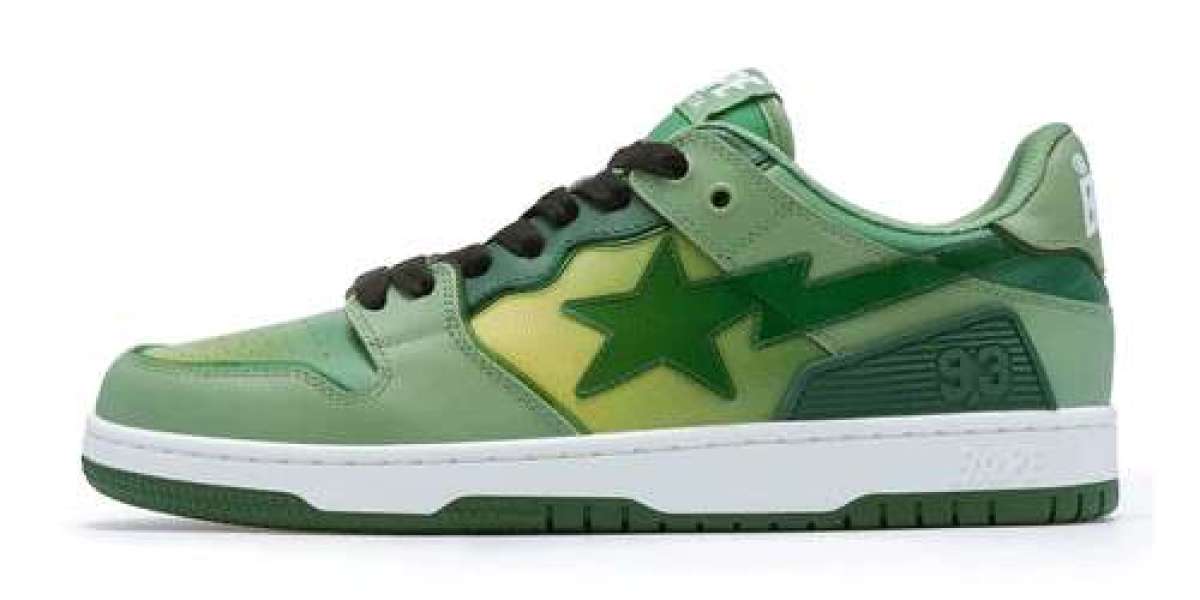When discussing the most iconic sneakers in streetwear history, one name always manages to rise above the noise — Bapesta. With its unmistakable silhouette, bold colorways, and cultural clout, the Bapesta sneaker has solidified its status as more than just footwear; it’s a lifestyle statement. From early 2000s hip-hop to the current wave of sneaker revivalism, Bapesta remains a symbol of rebellion, creativity, and bold fashion choices.
The Origin of Bapesta: A Bathing Ape’s Vision
The Bapesta story begins with Nigo, the legendary founder of A Bathing Ape (BAPE), a Japanese streetwear brand that has consistently pushed boundaries since its inception in 1993. Inspired by the pop-art-meets-street-culture ethos of Tokyo’s Harajuku district, Nigo sought to create fashion that spoke directly to youth culture. By 2000, he took the next step: launching the Bapesta sneaker — a shoe that would ultimately shake the global streetwear landscape.
Visually resembling the Nike Air Force 1, Bapesta was BAPE’s answer to the global sneaker obsession. But it wasn’t a simple imitation; it was a reimagination. Featuring a lightning bolt-like star logo instead of a swoosh and daring color schemes, Bapesta carved its own identity. It was flashy, fearless, and unlike anything else on the market at the time.
Bapesta and Hip-Hop: A Cultural Powerhouse
Bapesta’s rise to prominence was inseparable from the explosion of hip-hop culture in the early 2000s. American rappers and producers, particularly Pharrell Williams, Kanye West, and Lil Wayne, embraced the shoe, showcasing it in music videos, album covers, and street appearances. When Pharrell launched Billionaire Boys Club (BBC) alongside Nigo, the Bapesta naturally found its place at the center of this new fashion movement.
These early endorsements helped Bapesta break cultural and geographic boundaries. No longer just a Japanese phenomenon, it became a global status symbol — something you wore to stand out, not to fit in. This crossover into Western markets marked the sneaker’s golden era and cemented its place in fashion lore.
Design Language: Loud, Proud, and Playfully Retro
What set Bapesta apart wasn’t just celebrity co-signs. It was the unapologetically vibrant design. Patent leather finishes, pastel tones, camouflage patterns, and mismatched panels — Bapestas were never made for the shy. They embodied the maximalist spirit of Y2K fashion, where individuality reigned and subtlety took a back seat.
The signature STA logo, often mistaken for a lightning bolt, quickly became one of streetwear’s most recognizable symbols. And while Nike enthusiasts might initially call out the silhouette similarity, Bapesta leaned into its distinction with wild colorblocking and premium materials that emphasized fashion over function.
Today’s sneaker collectors view early 2000s Bapestas as grails — especially those rare releases tied to musicians, anime, and global artists.
Collaborations That Changed the Game
If there's one thing that keeps the Bapesta relevant two decades later, it’s collaborations. From Marvel and DC Comics to Coca-Cola, SpongeBob SquarePants, and more recently, Travis Scott and JJJJound — the list of Bapesta partners reads like a who’s who of pop culture.
Each collaboration brought something new to the table, whether through playful graphics, unique materials, or storytelling that transcended sneakers. These limited-edition drops turned casual fans into hardcore collectors and made release days into global events.
Even in 2025, Bapesta continues to fuel hype with exclusive drops and strategic partnerships. Collaborations with emerging Japanese artists and luxury fashion houses signal that the brand is adapting without losing its soul.
Bapesta in 2025: A New Generation of Fans
Streetwear is cyclical, and the Y2K aesthetic is currently enjoying a full-blown revival. For Gen Z and younger Millennials, Bapesta represents not only nostalgia but a bold alternative to today’s more minimalistic sneaker options.
Social platforms like TikTok and Instagram have reintroduced the shoe to millions of younger users, many of whom never experienced its initial hype. Styling videos, sneaker unboxings, and vintage resell finds have brought Bapesta back to the center of fashion conversations.
Brands like BAPE understand this momentum and have doubled down with retro reissues, gender-neutral sizing, and capsule collections targeting the TikTok generation. The digital era has ensured that Bapesta’s story is far from over.
Authenticity and the Rise of Counterfeits
With popularity, unfortunately, comes imitation — a reality that Bapesta fans have grappled with for years. Due to the shoe's high resale value and limited runs, counterfeit Bapestas flood secondary markets, especially online platforms.
To combat this, BAPE has improved authentication measures, including QR codes, serialized tags, and blockchain verification. Still, for new collectors, it’s crucial to buy from trusted resellers or directly from BAPE’s flagship stores and official website.
An internal link could be placed here to your site’s sneaker authentication guide or “how to spot fake Bapestas” article to add value for your readers.
Styling Bapesta: More Than a Sneaker
Wearing Bapesta is about making a statement. Whether paired with oversized denim, cargo pants, graphic tees, or techwear-inspired outfits, it always adds an element of boldness. Unlike neutral-toned sneakers meant to blend in, Bapesta demands attention.
In today’s fashion landscape where personalization is key, Bapesta gives wearers the freedom to express identity through design. The resurgence of baggy silhouettes, retro accessories, and vibrant palettes aligns perfectly with Bapesta’s DNA.
For a styling guide or “Top 10 Bapesta Looks of the Year,” this would be a good place to suggest an internal link to drive users further into your content ecosystem.
Sustainability and the Future of Bapesta
With sustainability top of mind in 2025’s fashion discourse, BAPE has made efforts to address concerns around mass production and environmental impact. Recent Bapesta lines incorporate recycled materials, vegan leather options, and more ethical manufacturing processes.
Although BAPE still faces criticism for exclusivity and pricing, the shift toward eco-conscious releases shows that the brand is willing to evolve. This sustainability angle could become a defining factor in how Bapesta appeals to future generations.
Why Bapesta Still Matters
In a world overflowing with sneaker drops and collaborations, very few manage to hold onto cultural relevance for over two decades. Bapesta is one of those rare exceptions. Its mix of nostalgia, bold design, and deep ties to music and youth culture gives it a timeless appeal.
Whether you're a long-time sneakerhead or a new fan diving into the Y2K wave, Bapesta offers something unique: a wearable piece of history that continues to influence fashion, music, and design.
Conclusion
The legacy of Bapesta isn’t just about shoes. It’s about rebellion, creativity, and standing out. As trends come and go, Bapesta remains a bold reminder of how streetwear can shape identity and culture. With its rich history, future-facing design choices, and a new generation of fans discovering its charm, Bapesta isn’t just surviving — it’s thriving.








